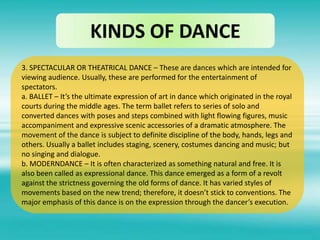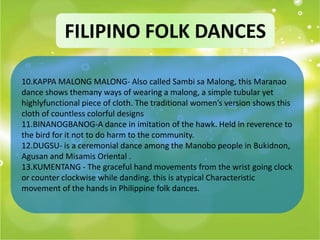Dance
- 1. THE ART OF DANCING It focuses on the discussion about the art of dance with particular objective of creating appreciation for the combined arts of body movement and music.
- 2. DANCE AS AN ART Dance is a rhythmic and expressive movement of the body in successive movement usually accompanied by music. It has been said to be the mother of the arts, for it’s the oldest of the art which actually reflects man’s age old need to communicate different emotions such as joy, grief, excitement and others. Dance simply started as man’s own life for almost all occasions, in whatever aspects, as birth, death, healing of the sick, asking for forgiveness, war, marriage – were celebrated by dancing. There are dances that express thankfulness for a good harvest, in celebration of religious festivities, or just a mere pleasurable expression of the body. It uniquely intensifies different moods and emotions that somehow deepen everybody’s feelings.
- 3. REASONS WHY DO PEOPLE DANCE •It has been used in worship. •It plays a role in courtship. •It serves as a form of acquaintance for a man and woman. •It is an expression of the joy one feels. •As in old times, it brings magical power s to people. •It brings victory or somehow restores health to life. •It even breaks the monotony of the daily activities. •It serves to entertain others. •It gives beauty and inspiration to others. •It provides personal and effectiveness of communication.
- 4. SIGNIFICANT FEATURES OF THE DANCE AS AN FORM Two kinds of movement 1.Movement within the body which includes the hand and arms. 2.Movement from one space to another.
- 5. Features of Dance 1.MUSIC – It is closely related to dance for it plays a significant role in it. It is used as accompaniment that somehow motivates the dancer’s movement. 2.MOVEMENT – It refers to action of dances with the use of their bodies to create organized patterns. 3.THEME – It pertains to the content or main ingredient of the dance. It actually conveys the message of the dance. 4.TECHNIQUES - It refers to the skill in executing movement. As a dancer, one needs to have a complete control over the muscles of his body for him to be said technically proficient. 5.DESIGN – It refers to the arrangement of movements according to pattern in time (either fast or slow) and space (one’s position in relation to his background). 6.PROPERTIES AND COSTUME – These contribute to the visual effect of dance. The costumes can somehow relate closely to the beliefs and environment of people.
- 6. KINDS OF DANCE 1.ETHNOLOGIC DANCE – This is a dance that is indigenous to a certain race or country. The term ethnic is used to distinguish religious dances, and designed as hymns of praise to a god, or to bring on good fortune in peace and war. They are symbolic in meaning that can’t be understood easily by persons who don’t belong to the ethnic group. 2. SOCIAL DANCE – These are popular type of dancing for pleasure as generally performed by pairs or group of people following a definite step or pattern. Most of these have specific rhythms and coordinated with the movement and steps of the body, hand, foot and head. a. BALLROOM DANCE – It actually originated as square dance which was followed by waltz, tango, foxtrot, swing, etc. b. FOLK DANCE – It usually derived from ethnic dances. People all over the world have their own folk dances as distinct to their specific culture.
- 7. KINDS OF DANCE 3. SPECTACULAR OR THEATRICAL DANCE – These are dances which are intended for viewing audience. Usually, these are performed for the entertainment of spectators. a. BALLET – It’s the ultimate expression of art in dance which originated in the royal courts during the middle ages. The term ballet refers to series of solo and converted dances with poses and steps combined with light flowing figures, music accompaniment and expressive scenic accessories of a dramatic atmosphere. The movement of the dance is subject to definite discipline of the body, hands, legs and others. Usually a ballet includes staging, scenery, costumes dancing and music; but no singing and dialogue. b. MODERNDANCE – It is often characterized as something natural and free. It is also been called as expressional dance. This dance emerged as a form of a revolt against the strictness governing the old forms of dance. It has varied styles of movements based on the new trend; therefore, it doesn’t stick to conventions. The major emphasis of this dance is on the expression through the dancer’s execution.
- 8. The Elements of Dance Body Action Space Time Energy
- 9. FILIPINO FOLK DANCES 1.PANDANGO SA ILAW – It’s typical folk dance originated in Ilokano region. It’s a very popular dance which express in different versions. It is the most difficult for the female dancers that they have to balance these oil lamps, one on her head and two on each palm. It’s a dance of grace and skill. 2.ITIK-ITIK – This fascinating dance originated from a dance called sibay. It is a native dance interpreting the playfulness if duckling wading in the river. 3.HABANERA SOLTERA – This dance is from Ilocos Sur. This dance is performed by the bride to be and her close friends at the traditional social gathering on the eve of the wedding. This is bride’s farewell to the state of single blessedness.
- 10. FILIPINO FOLK DANCES 4.SINGKIL – It’s a dance based on the Maranao epic “Bantugan”. It features a beautiful princess dancing gracefully over clashing bamboo pole nimble followed by a nimble prince. It is a Lanao court dance which women of royal blood have to learn. 5.TINIKLING – It is a native dance presenting using long bamboo sticks from which the dancers hop from one pole to another. 6.JOTABAL 7.PANDIWATA 8.OBANDO-amed after a town in Bulacan. Obando Dance is a dance of rural Philippines. Attire is the native "balintawak" and "salakot" for the ladies and "barong tagalog and "buntal" hats for the gentlemen. 9.SAKUTING- a folk dance of the Ilocanos usually performed during Christmas. Groups of boys and girls go to perform from house to house receiving many gifts in return. Note the two sticks used to produce the rhythmic sound. (Baranggay Folk dance Troupe Philippine Normal College).
- 11. FILIPINO FOLK DANCES 10.KAPPA MALONG MALONG- Also called Sambi sa Malong, this Maranao dance shows themany ways of wearing a malong, a simple tubular yet highlyfunctional piece of cloth. The traditional women’s version shows this cloth of countless colorful designs 11.BINANOGBANOG-A dance in imitation of the hawk. Held in reverence to the bird for it not to do harm to the community. 12.DUGSU- is a ceremonial dance among the Manobo people in Bukidnon, Agusan and Misamis Oriental . 13.KUMENTANG - The graceful hand movements from the wrist going clock or counter clockwise while danding. this is atypical Characteristic movement of the hands in Philippine folk dances.
- 12. FILIPINO FOLK DANCES DUGSO
- 13. FILIPINO FOLK DANCES BINANOGBANOG
- 14. FILIPINO FOLK DANCES OBANDO
- 15. FILIPINO FOLK DANCES KUMENTANG
- 16. FILIPINO FOLK DANCES SAKUTING
- 17. FILIPINO FOLK DANCES KUMINTANG
- 18. SAMPLES OF DANCE MODERN DANCE
- 19. SAMPLES OF DANCE SOCIAL DANCE
Editor's Notes
- For many generations, dancing can be both art and recreation. As an art, it states a story and sets one’s mood to express certain emotions. As a form recreation, it somehow provides relaxation, companionship and enjoyment.Dance is really a combined art – as it gives emphasis on the movements of the body and timed to music. It’s really hard to imagine a dance without music. In the sense therefore, a dance can be well-performed if it employs costumes, lighting, some stage sceneries and music.
- KINDS OF DANCEDance may be engaged in varied forms as religions, magical, ceremonial, commemorative, recreational or entertainment in purpose. These are follows:1. ETHNOLOGIG DANCE-It includes folk dancing because they are often derived from ethnic dances. Folk dancing has become part of the customs and traditions of people. And most folk dances developed among people in villages and were passed on from one generation to the next in many regions. Through these folk dances, we can actually hears something about the culture of people – the beliefs, habits, interest, desires, and others This helps us to discover more about our own heritage. Now, it has undergone much refinement from a mere lusty dancing to a more orderly dancing. It has grown already to larger dimensions for it has been embraced by the people.
- KINDS OF DANCEDance may be engaged in varied forms as religions, magical, ceremonial, commemorative, recreational or entertainment in purpose. These are follows:1. ETHNOLOGIG DANCE-It includes folk dancing because they are often derived from ethnic dances. Folk dancing has become part of the customs and traditions of people. And most folk dances developed among people in villages and were passed on from one generation to the next in many regions. Through these folk dances, we can actually hears something about the culture of people – the beliefs, habits, interest, desires, and others This helps us to discover more about our own heritage. Now, it has undergone much refinement from a mere lusty dancing to a more orderly dancing. It has grown already to larger dimensions for it has been embraced by the people.
- Dance has its own content, vocabulary, skills, and techniques, which must be understood and applied to be proficient in the art. The elements of dance are the foundational concepts and vocabulary for developing movement skills as well as understanding dance as an art form. All these elements are simultaneously present in a dance or even in a short movement phrase.http://opd.mpls.k12.mn.us/the_elements_of_dance
- FILIPINO FOLK DANCESFolk dancing in the Philippines can be said as an expression of nationalism for it depicts the traditions and culture of the people. It provides wholesome recreation and aesthetic satisfaction and the preservation of our cultural heritage. As in most regions in the Philippines, materials for folk dances are abundantly present. Filipinos are music lovers endowed with talents for dancing. They express their thoughts and feelings through rhythmic movements in folk dances. Therefore, it is said to be forms of entertainment enjoyed by all ages.
- LAST




















